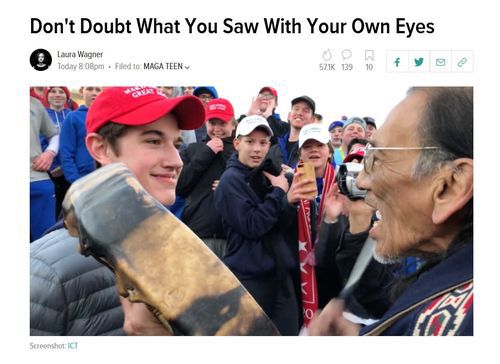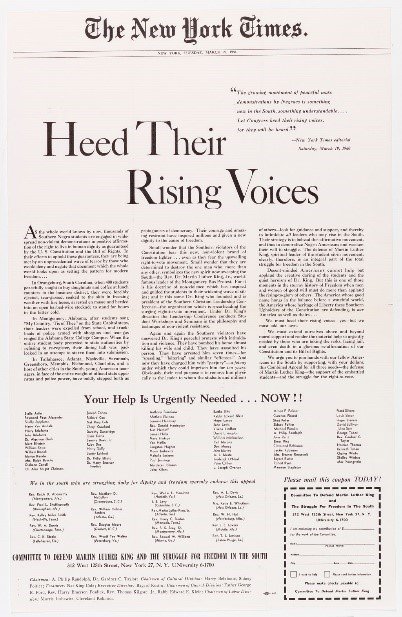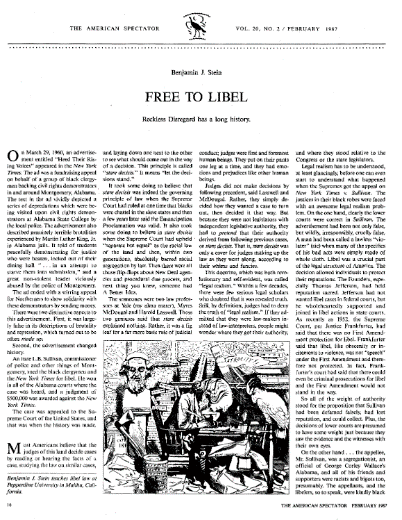

02/28/2019

A recent comment by Clarence Thomas on a libel suit has led to panic in newsrooms and editorial offices across the country. You see, under the New York Times Co. v. Sullivan, the press has the right to lie about public officials like Donald Trump or Steve King. This was expanded to give them the the right to lie about ordinary people if they can be called public figures.
Public figures like MAGA hat-wearing teenager Nick Sandmann (right) or various "Beckys" who are public figures only because they've been attacked by the press … after being threatened by minorities. In the case that led Clarence Thomas to comment, one of Bill Cosby’s many victims was libelled by Cosby’s lawyer. She became a "limited purpose public figure",first by being raped by Bill Cosby (in private) and then by accusing him of it publicly.

This came about because in 1964, various Southern whites were libelled in an ad in The New York Times called "Heed Their Rising Voices", run by the Committee to Defend Martin Luther King and the Struggle for Freedom in the South. (I. E. a bunch of black civil rights preachers.) In order to let the Times and the black preachers off the hook, the Court had to rewrite the law.
Tennessee law professor Glenn Reynolds writes:
As even liberal law professor Cass Sunstein commented: “Thomas is right to point out that the constitutional foundations of New York Times v. Sullivan are not entirely firm.” And it’s also true that the case’s original holding — in response to a coordinated plan by southern segregationist officials to use libel suits (brought in front of sympathetic local juries) to punish the national press for unfavorable coverage — has been expanded to cover all sorts of other cases, such as Cosby’s.
Clarence Thomas is right: Here’s why Supreme Court should revisit libel law overreach
Glenn Harlan Reynolds, USA Today, February 28, 2019
That’s one view of what the court did, and what Southern officials were doing in self-defense.
Writing about a case where James Edwards was libelled I called this the right of the MSM, gained as a by-product of the Civil Rights era, to lie even when their lie is pointed out to them.
This precedent was first established in 1960. L. B. Sullivan, the white Montgomery Public Safety Commissioner, sued The New York Times for libelling him. The New York Times has frequently been willing to libel white Southerners on its own motion, but this was an advocacy advertisement, headed “Heed Their Rising Voices,” by the "Committee to Defend Martin Luther King and the Struggle for Freedom in the South":
Many of the statements in this ad were factually incorrect. Furthermore, many of the black icons alleged to have signed it, hadn’t.
Nevertheless, the U.S. Supreme Court found, in the landmark decision New York Times Co. v. Sullivan that the press had, in effect, the right to publish untruths about things like this, as affecting government officials, since otherwise, citizens couldn’t protest an unjust government.
Two quotes about the right to lie, from Justice Brennan, writing for a unanimous court:
The writer (and Yale Law School valedictorian) Ben Stein described how this came about in 1987 in the pages of the American Spectator: Free to Libel | Reckless Disregard has a long history, February 1987, pp. 16-17.

After explaining the theory of “legal realism” which is that judges tend to decide what they think the law should be and make up a rationalization for it, and also explaining that L. B. Sullivan had been indeed libelled, and had won in an Alabama court, Stein wrote that, nevertheless,
How could the same Supreme Court which had only a few years earlier thundered against racial segregation in Brown v. Board of Education now possibly turn its back on the brave fighters for racial decency and give half a million real bucks to the racist swine, no matter what the decisions said?They couldn’t. The result, as [legal realism theorists] Lasswell and McDougal would have predicted, was a unanimous Supreme Court reversal of the Alabama courts and a decision, penned by William Brennan, which set libel law on its head.
In a long, bizarre decision marked by an almost unbelievable misuse and abuse of precedents, Brennan quoted Mill, quoted Milton, quoted cases on totally unrelated matters such as membership lists and contempt of court, and announced a brand-new rule about libel. Of course, he said it was the same old rule, but no one quite fell for that. Somehow, this was a completely new rule and at the same time it followed all of the old cases. It was a clever trick, and for those who want to see it in action, the case can be found in your law libraries at 376 U.S. 254.
Of course that was in 1987 — you can now read the decision online at Wikisource.
In one of my first articles for VDARE.com, I pointed out that black Affirmative Action hire Jayson Blair, who had famously lied to the NYT again and again, was working for a newspaper that had defended its own right to lie to the public.
And now it’s being used to allow a rapist’s lawyer to libel one of the rapist’s victims because she’s a "public figure" which just means that she’s in the news.